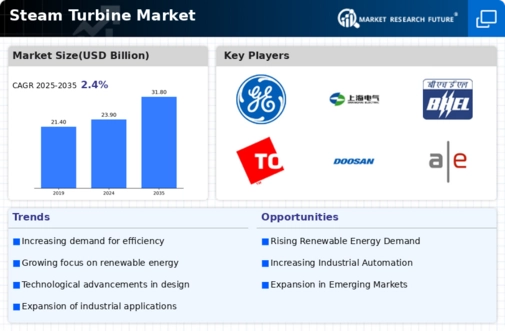Top Industry Leaders in the Steam Turbine Market

*Disclaimer: List of key companies in no particular order
The Steam Turbine Market's Competitive Terrain Thriving through Efficiency and InnovationThe steam turbine market, fundamental to traditional power generation, stands at a crossroads. Amidst escalating competition from renewable energy sources, it is recalibrating and innovating to maintain relevance in an evolving energy landscape. Grasping the nuances of this competitive arena is pivotal for effectively navigating its complexities.Key Players and Their Strategies:Strategies of Major Players:Dominant players like General Electric (GE), Siemens AG, Mitsubishi Hitachi Power Systems (MHPS), and Toshiba dictate the market. These industry giants harness their extensive experience, global reach, and robust research and development to retain their positions. For instance, GE focuses on modular designs and advanced materials for efficiency enhancements, while Siemens stresses digitalization and service solutions. MHPS targets specialized segments like geothermal and concentrated solar power.Rising contenders like Doosan Heavy Industries and Shanghai Electric disrupt the status quo with competitive pricing and tailored offerings, challenging established norms. Regional entities like Bharat Heavy Electricals Limited (BHEL) in India cater to specific local demands, carving their unique niche.Market Share Analysis:Critical factors such as capacity, geographical presence, technological repertoire, and customer base significantly influence market share. Presently, GE leads with approximately 25% share, followed by Siemens and MHPS. Nonetheless, this landscape remains dynamic, impacted by regional players and technological progressions.New and Emerging Trends:Prominent trends influencing the competitive landscape encompass:Emphasis on Efficiency: Driven by environmental regulations and cost constraints, steam turbine manufacturers prioritize efficiency enhancements. Innovations in blade designs, deployment of materials like titanium alloys, and refined cooling systems optimize energy output.Surge of Combined Cycle Plants: The fusion of steam turbines with gas turbines in combined cycle power plants gains momentum due to superior efficiency. Industry leaders like Siemens and GE spearhead this segment.Smaller and Medium Turbines: Escalating demand for decentralized power generation fuels the market for more flexible, smaller steam turbines applicable across industries like oil & gas and biomass. Doosan Heavy Industries and Ansaldo Energia are influential players here.Digitalization and Service Solutions: Tools like digital twins, predictive maintenance, and remote monitoring play pivotal roles in performance optimization and downtime reduction. Siemens and Mitsubishi are heavily invested in these realms.Sustainability Focus: Escalating concerns regarding emissions prompt manufacturers to explore alternative fuels such as hydrogen and biomass for steam turbines. GE and MHPS actively partake in such advancements.Competitive Scenario:The overarching competitive scene is characterized by:Intense Price Competition: Striving with tight margins and price-conscious customers, the market faces persistent pricing pressure. Emerging players often leverage lower labor costs to offer competitive rates.Technological Innovation: Continuous strides in materials, designs, and control systems remain imperative for differentiation and sustaining a competitive edge.Emphasis on Collaborations and Acquisitions: Partnerships and strategic acquisitions become commonplace for accessing new markets, technologies, and talent.Adaptability to Market Dynamics: The ability to flexibly respond to evolving regulations, fuel sources, and consumer preferences proves pivotal for long-term viability.Looking Ahead:The steam turbine market confronts challenges but harbors substantial potential. As the spotlight shifts towards efficiency, seamless clean energy integration, and adaptable solutions, innovators and adaptors of these trends will flourish. The key lies in catering to diverse requisites and offering comprehensive solutions, encompassing not just turbines but also services and digitalization. This approach becomes pivotal for navigating the competitive terrain and securing a firm foothold in the evolving energy landscape.Industry Developments and Latest Updates:General Electric (US):- October 2023: GE Steam, a GE Renewable Energy business, introduced its HA.L technology, a next-gen high-efficiency steam turbine platform. (Source: GE Renewable Energy press release)- September 2023: GE Power clinched a contract to provide four H90 turbines for an Egyptian combined cycle power plant. (Source: GE Power press release)Siemens AG (Germany):- November 2023: Siemens Energy unveiled the SGT5-8000H hydrogen-ready gas turbine, adaptable for 100% hydrogen operation in the future. (Source: Siemens Energy press release)- October 2023: Siemens Energy bagged a contract to deliver two HL-class steam turbines for a nuclear power plant in China. (Source: Siemens Energy press release)Mitsubishi Heavy Industries Ltd (Japan):- November 2023: MHI announced the development of a high-efficiency steam turbine with a net thermal efficiency exceeding 45%. (Source: MHI press release)- September 2023: MHI delivered its 1,000th M701F gas turbine, a pivotal component in steam turbine combined cycles. (Source: MHI press release)

